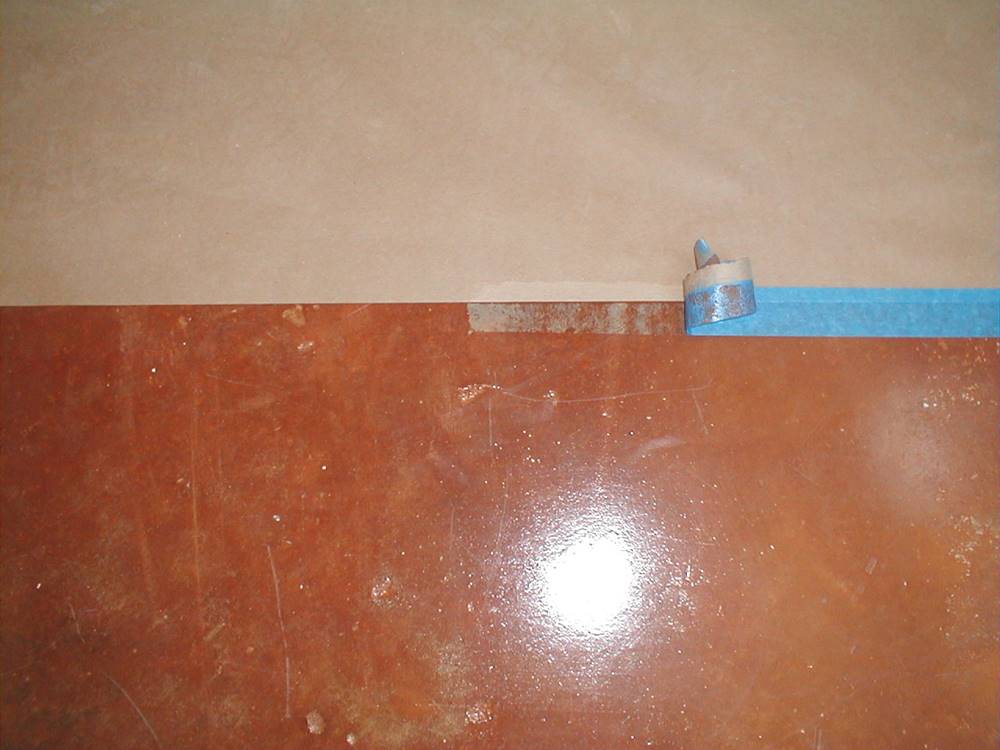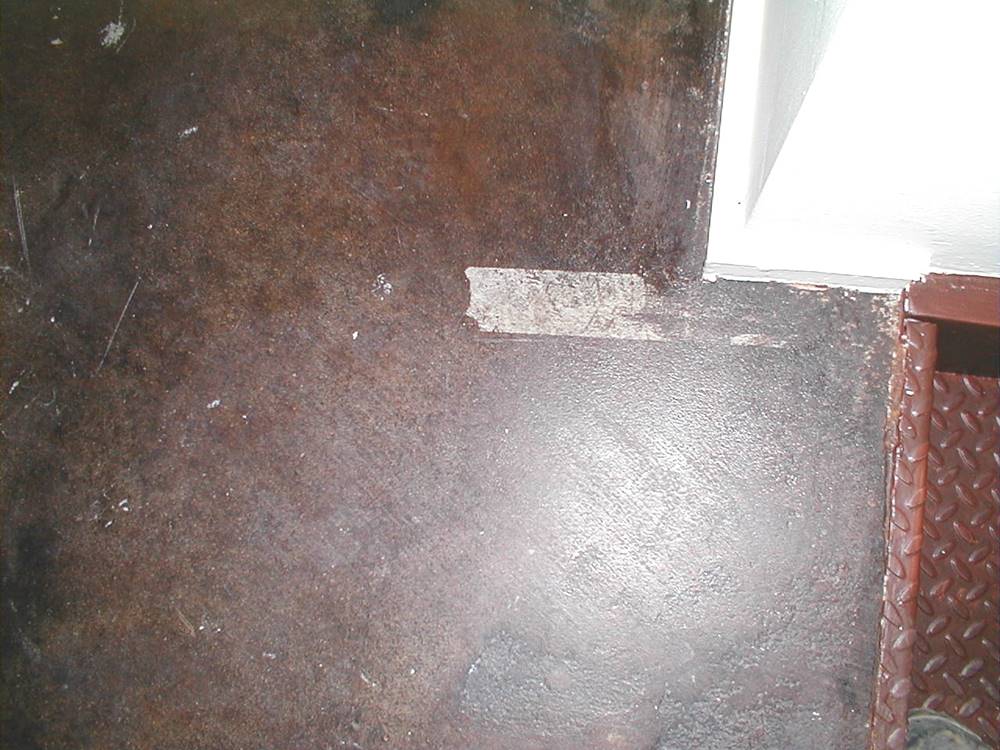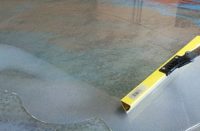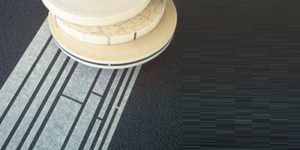
A while back a large manufacturer of tapes and adhesives for the construction industry approached me. They wanted to learn about the types of adhesives and tapes used by decorative concrete applicators as well as the common problems with tape on concrete. Their area of interest focused on what problems applicators had when using their products on typical decorative jobs.
I didn’t have to think very long or hard to put together a list of suggestions and common problems with tape on concrete. Like a lot of ancillary products used by decorative installers, the tapes and adhesives used in the industry typically come from other markets and are nothing more than the best option available at that time. Sometimes these crossover products do the job. However, other times they fall short and cause problems.
Most know that the decorative concrete industry has struggled with tape issues for decades. These range from tape tearing when overlays are applied, to stain bleeding under the tape, to adhesive effectiveness when the tape gets wet.
But by far the one of biggest problems with tape on concrete in the decorative industry is the issue of chemical weld between tape and sealers causing sealer failure when the tape is pulled. Interestingly enough, it’s not widely discussed and even less understood. I was one of the first to identify this issue as a problem in our industry more than 10 years ago. And I still include the topic in most all of my troubleshooting presentations today.
Tape on fresh install
There’s nothing worse than completing a beautiful stain or stamped concrete project where everyone is happy and you’re paid on time, only to get that dreaded phone call — we have a problem!
The painting contractors or homeowner taped protective paper to the decorative floor two weeks after you completed the job. When they pulled the tape up the next day, it took all the sealer and stain with it. This left a long ugly narrow strip everywhere they had applied tape. This is a big problem. To make it worse, the owner usually ends up falsely accusing the decorative installer of poorly installing the original work.
The above scenario actually takes place more often than most in our industry realize. The problem occurs with all types of tape, even the blue and green low-adhesive brands, and on all types of sealed floors. I have found it occurs more often with acrylic sealers and when the sealer is less than one month old.
Blame the tape’s resin
The main culprit for this issue lies with the flexibility and type of resin used on most construction tape. When you take a closer look at the glue on the back of the tape, you see that it is very flexible. The glue gets its flexibility from plasticizers, namely additives used to make plastics and rubbers softer and more flexible. For example, high-performance car tires have a lot of plasticizer. This makes them softer, allowing for a better grip on the road.
Those plasticizers allow the glue to flow or “migrate” to form a better bond with the surface. Since most decorative sealers have some porosity, the glue migrates into those pores, forming a very strong bond. When you remove the tape, if that bond between the tape and sealer exceeds the strength of the sealer’s bond to the concrete, the sealer — and often the stain as well — comes off too.
(The term “plasticizer migration” that has been used to describe this phenomenon isn’t completely accurate. The plasticizer doesn’t migrate out of the glue. Rather, it allows the glue to migrate into the sealer. I think a better term would be glue migration.)
There’s another problem too. The acrylic resin used in the glue on most tape is similar to the acrylic resins found in most decorative sealers and cure-and-seal products. When you apply an acrylic sealer, you need a certain drying window for the sealer to form that hard-wearing surface.
The sealer may be dry to the touch one to two days after application, but that doesn’t mean the sealer has completely dried chemically. The process may take weeks depending on temperature, humidity and how thick someone applied the sealer.

A strong bond
When you use tape with acrylic glue on a floor with an acrylic sealer still chemically drying, the two acrylic resins can form a very strong and permanent chemical bond. I’ve seen cases where this bond is so strong that when the tape was removed it did not just pull up the sealer and stain. It also took off the top 1/16-inch of the concrete.
This is why the issue of tape pulling sealers off concrete tends to occur with newer sealed floors. But don’t let this fool you — the chemical weld between acrylic resins can take place at any time if the right conditions exist. It can also take place between tape and other common decorative sealer resins such as polyurethanes, epoxies, polyaspartics and polyureas.
If you have to repair a floor where tape has removed the sealer and color, the best approach I have found involves using faux finish techniques with tints and stains to touch up the color in the taped areas, followed by resealing. A more invasive approach involves chemically stripping the entire floor, recoloring, then resealing.
The issue of glue migration is not selective to sealed surfaces. I’ve seen significant damage done when installers apply tape to unsealed concrete prior to staining. The same process occurs, but instead of the glue migrating into the sealer, it migrates into the concrete. When the installer pulls the tape some of the glue remains in the pores of the concrete. The downside is that you can’t see it until the concrete is stained, at which time it shows up as a blotchy line on the floor.
Test before staining
This is another good reason to do a water test on the concrete prior to staining — the glue line will show up and give you a chance to deal with it prior to staining the floor. If you need to remove glue from a concrete floor, a solvent wash to liquefy the glue followed by a light scrub and dabbing with a rag works best.
As with anything in nature, time and temperature play a part. As the temperature rises, so the does the speed of reaction. The speed of “glue migration” and “chemical weld” increase as the temperature rises and the longer the two surfaces are in contact.
I promote tape abstinence on any floor that is going to get a decorative finish and especially on any floor that has been sealed. Of course this can change when and if manufacturers develop tape products for the decorative concrete industry with these issues in mind.
Questions from Reader
Question
We’re building a home which has a polished concrete floor with charcoal color integral stain mixed in. Our builder poured and sealed about 10 months ago. They’re now ready to paint the trim. Our builder isn’t concerned about the painters using blue tape for taping paper to the floors because it’s been curing for so long. However, I’m still pretty concerned after reading so much about the issues with tape and concrete. Do you think this will be an issue? How does trim get painted without putting tape on the floor?
Answer from Concrete Decor
Your concerns are justifiable.
Polished concrete often includes a sealer coating referred to as a “guard.” Apply the guard at the end of the polishing process and then burnish to cure and harden the coating. I haven’t heard of a problem occurring with masking tape adhesive pulling that coating off the floor, BUT that doesn’t mean it can’t happen.
I recommend using a painter’s “green tape” (aka Frog Tape) in place of blue tape. It’s a lighter-duty masking tape used on sensitive surfaces. It will do an equally good job of protecting the surface. Also, discourage your painter from leaving this masking down on the floor for an extended period of time.















